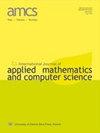Hybrid Cryptography with a One–Time Stamp to Secure Contact Tracing for COVID–19 Infection
IF 1.2
4区 计算机科学
Q3 AUTOMATION & CONTROL SYSTEMS
International Journal of Applied Mathematics and Computer Science
Pub Date : 2022-03-01
DOI:10.34768/amcs-2022-0011
引用次数: 3
Abstract
Abstract The COVID-19 pandemic changed the lives of millions of citizens worldwide in the manner they live and work to the so-called new norm in social standards. In addition to the extraordinary effects on society, the pandemic created a range of unique circumstances associated with cybercrime that also affected society and business. The anxiety due to the pandemic increased the probability of successful cyberattacks and as well as their number and range. For public health officials and communities, location tracking is an essential component in the efforts to combat the disease. The governments provide a lot of mobile apps to help health officials to trace the infected persons and contact them to aid and follow up on the health status, which requires an exchange of data in different forms. This paper presents the one-time stamp model as a new cryptography technique to secure different contact forms and protect the privacy of the infected person. The one-time stamp hybrid model consists of a combination of symmetric, asymmetric, and hashing cryptography in an entirely new way that is different from conventional and similar existing algorithms. Several experiments have been carried out to analyze and examine the proposed technique. Also, a comparison study has been made between our proposed technique and other state-of-the-art alternatives. Results show that the proposed one-time stamp model provides a high level of security for the encryption of sensitive data relative to other similar techniques with no extra computational cost besides faster processing time.带有一次性戳记的混合加密技术可确保COVID-19感染的接触者追踪
COVID-19大流行改变了全球数百万公民的生活和工作方式,使其符合所谓的社会标准新规范。除了对社会造成非同寻常的影响外,这次大流行还造成了一系列与网络犯罪有关的独特情况,这些情况也影响到社会和企业。大流行带来的焦虑增加了网络攻击成功的可能性,以及它们的数量和范围。对于公共卫生官员和社区来说,位置跟踪是抗击这种疾病的一个重要组成部分。各国政府提供了大量移动应用程序,帮助卫生官员追踪感染者,并与他们取得联系,帮助他们了解健康状况,这需要以不同形式交换数据。本文提出了一次性戳记模型作为一种新的加密技术来保护不同的联系表单和感染者的隐私。一次性戳记混合模型以一种全新的方式组合了对称、非对称和散列加密,这与传统的和类似的现有算法不同。已经进行了几个实验来分析和检验所提出的技术。此外,我们提出的技术和其他最先进的替代方案进行了比较研究。结果表明,相对于其他类似技术,所提出的一次性戳记模型为敏感数据的加密提供了高水平的安全性,除了更快的处理时间外,没有额外的计算成本。
本文章由计算机程序翻译,如有差异,请以英文原文为准。
求助全文
约1分钟内获得全文
求助全文
来源期刊
CiteScore
4.10
自引率
21.10%
发文量
0
审稿时长
4.2 months
期刊介绍:
The International Journal of Applied Mathematics and Computer Science is a quarterly published in Poland since 1991 by the University of Zielona Góra in partnership with De Gruyter Poland (Sciendo) and Lubuskie Scientific Society, under the auspices of the Committee on Automatic Control and Robotics of the Polish Academy of Sciences.
The journal strives to meet the demand for the presentation of interdisciplinary research in various fields related to control theory, applied mathematics, scientific computing and computer science. In particular, it publishes high quality original research results in the following areas:
-modern control theory and practice-
artificial intelligence methods and their applications-
applied mathematics and mathematical optimisation techniques-
mathematical methods in engineering, computer science, and biology.

 求助内容:
求助内容: 应助结果提醒方式:
应助结果提醒方式:


